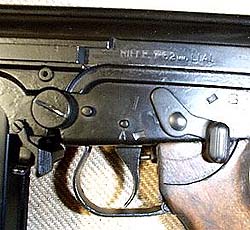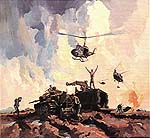Sounds of War

Principles of War
Selection and Maintenance of the Aim
Morale
Offensive Action
Security
Surprise
Surprise can decisively shift the balance of combat power. By seeking surprise, forces can achieve success well out of proportion to the effort expended. Rapid advances in surveillance technology and mass communication make it increasingly difficult to mask or cloak large-scale marshaling or movement of personnel and equipment. The enemy need not be taken completely by surprise but only become aware too late to react effectively. Factors contributing to surprise include speed, effective intelligence, deception, application of unexpected combat power, operations security (OPSEC), and variations in tactics and methods of operation. Surprise can be in tempo, size of force, direction or location of main effort, and timing. Deception can aid the probability of achieving surprise.
Concentration of Combat Power
Economy of Effort
Flexibility
Unity of Command
Administration and Logistics
Simplicity
- "War: A Matter of Principles"
Air Marshall David Evans
ISBN 0 642 26555 0 - U.S. Army, Field Manual 100-5, 1994 (Unclassified)
Sound played a big part in the war in Vietnam as it does in any war.
Hearing the sound of tracks screeching and the roar of a large engine you could be sure it was a Centurion Tank moving about.
An APC has a distinctive sound, a softer sound than a Centurion Tank because it had different tracks, in that, they are smaller and are padded with rubber. The diesel engine was distinctive in sound.
The sound of a M16 Rifle was distinctive; some called the sound a bark
The enemy would identify these sounds and marry them up with the size of the force they could be up against.
- Tanks travel in threes and usually have troops with them; at least a company of infantry.
- APCs travel in threes and you would expect them to have a platoon or company of infantry at well.
- If a M16 (semi-automatic assault rifle) was heard on its own you would assume there was at least a section of infantry; if a M60 (medium machine gun) was heard it would confirm a section/platoon sized force.
- 30cal machine gun could be at least an APC, a Tank, or a roadrunner Landrover escorting a convoy.
- 50cal machine gun would probably indicate the presence of Centurion Tanks, and/or APCs; it could be expected a company of grunts were there as well.
Usually a battalion will tackle a company; a company will take on a platoon;a platoon a section and a section, individuals.

The self loading rifle - L1A1 SLR
The SAS discovered that when an L1A1 self loading rifle with the flash eliminator removed was fired, it sounded almost identical to an 50cal machine gun. Further they discovered that a skilled soldier, spacing his shots, from an L1A1, converted to automatic and with the flash eliminator removed, could give the impression that he was firing a 50cal machine gun; falsely indicating the presence of armoured vehicles and a larger force of infantry. The effect the sound of such a weapon would have on the actions of an enemy patrol on locating elements of an SAS patrol is easily imagined.

Flash Eliminator - L1A1 SLR
The problem was that at the end of the barrel, where it is threaded to take the flash eliminator, is very thin, so thin in fact that the end of the barrel will split after only a few shots without the flash eliminator fitted.
As Task Force Armourer, I backed up the Unit Armourers servicing the battalions and the SAS Squadron. It was urgent for SAS immediate operational needs (especially for the weapon carried by the forward scout) that the splitting of the barrels and conversion to automatic fire of the L1A1 rifles be solved.
Barrel Failure:- It was obvious that threaded area that was failing needed to be reinforced. I made up a feral (like a treaded sleeve with a blind end) that screwed onto the barrel replacing the flash eliminator. This was successful in preventing the splitting while not interfering with the sound of the weapon.

receiver/trigger area - L1A1 SLR
Automatic Firing:- There were a number of methods available to convert the self loading rifle so that it fire on automatic.
- A common method used by the armourers was to weld a bronze strip on the trigger mechanism
- I found it worked better if the trigger sear under face was welded, built up and then filed down to give a good finish. This modification allowed the breach block to work continuously till the sear was released by the trigger that then held the breach block to the rear.The user of the welded method had to be very careful and skilful if he wanted to fire single shots.
- Another method was to change the trigger mechanism and the change lever for one that was on the SLR L1A2, the heavy barrel version. This made the SLR fully automatic as well as having the added advantage of selecting single shot. One of my first jobs on arrival in country at the Free World HQ was to convert two SLRs that belonged to members of Australian Army Training Team Vietnam (AATTV), Maj G.M. (Curly) Templeton, RAAC and WO Bill Grogan RAEME, old friends who were working in the Delta Area.
- Cfn Mike Staples, Armourer at C Sqn 1Armd Regt, Vietnam, reports that he found the easiest way to make the SLR fully automatic with the use of single shot was to file off 4mm from the trigger return plunger and replace the change lever for one off the AR L1A2.


